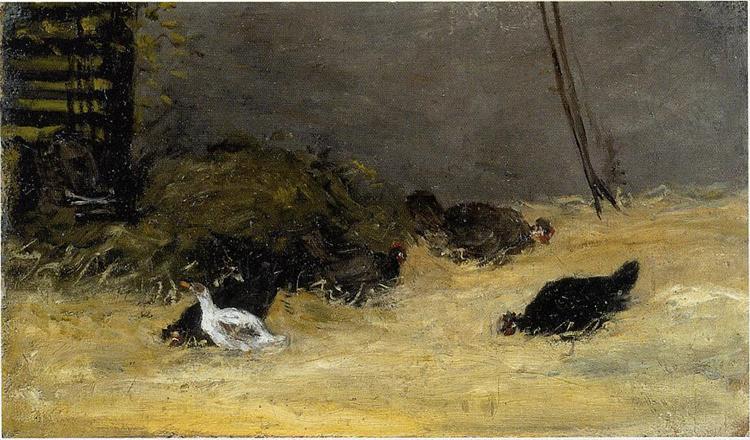Beschreibung
Paul Gauguins "Chicken Coop" (1875) wird in eine entscheidende Zeit der künstlerischen Entwicklung des französischen Malers eingefügt, der nach seiner Suche nach Stilen und Themen auffiel, die die Konventionen seiner Zeit in Frage stellten. In dieser Arbeit präsentiert Gauguin eine reiche Szene in Farbe und Textur, in der er eine bemerkenswerte Interaktion zwischen den Elementen der Natur erreicht und sein Interesse an Alltag und Land betont. Auf den ersten Blick mag "Hühnerstall" eine triviale Darstellung eines landwirtschaftlichen Raums erscheint, aber genau in dieser offensichtlichen Einfachheit, in der sich seine Komplexität und Tiefe befinden.
Die Zusammensetzung des Gemäldes ist mit einem Ansatz zur Vertikalität und Nutzung des Raums organisiert. In der Mitte finden wir eine hölzerne Struktur, die den gleichen Hühnerstall zu sein scheint, dessen Linien eine kleine, aber bedeutende Welt rahmen, die sich um sie herum entfaltet. Die Hühner mit ihren Formen und lebendigen Farben sind im Weltraum verteilt und bieten Bewegung und Dynamik für die Arbeit. Die dreieckige Bauform in der Mitte wird durch die Vögel im Vordergrund ausgeglichen, die es schafft, die Monotonie des Hintergrunds zu brechen, während der Blick des Betrachters auf die Aktivität in diesem ländlichen Szenario führt.
Die Farbe in "Chicken Coop" ist einer der auffälligsten Aspekte des Malerei. Gauguin, bekannt für seine intensive und ausdrucksstarke Farbe von Farbe, wendet eine Palette an, die warme Rottöne von Gelb und Orange abdeckt, die eine lebendige Darstellung von Vögeln ermöglichen. Diese chromatische Entscheidung hat auch emotionale Auswirkungen, was auf eine enge Verbindung mit dem ländlichen Lebens und ein Gefühl der Freude durch eine tägliche Feier hinweist. Darüber hinaus wird die Farbe der Farbe auf der Oberfläche des Gemäldes mit seiner charakteristischen Technik kombiniert, bei der direkte und oft dicke Pinselstriche eine spürbare Textur bieten, die visuelle Erfahrung bereichert.
In Bezug auf die Charaktere enthält die Arbeit keine menschlichen Figuren, was Vögel zu den ausschließlichen Protagonisten der Komposition macht. Dieser Ansatz deutet nicht nur auf eine Aufgabe des traditionellen Ansatzes zur Repräsentation hin, sondern zeigt auch Gauguins Faszination für die Symbolik in der Natur. Die Hühner können in diesem Zusammenhang als Ikonen des Alltags interpretiert werden und bringen den Betrachter in eine tiefere Reflexion über die Existenz in einer ländlichen Umgebung.
Es ist relevant, den Kontext zu erwähnen, in dem "Hühnerwall erstellt wird. In den 1870er Jahren wurde Gauguin in die Erforschung von Themen eingetaucht, die das ländliche Leben mit einem modernistischen Ansatz kombinierten, der die Traditionen der akademischen Kunst in Frage stellte. Die Arbeiten sind in der Gruppe von Gemälden registriert, die immer noch nicht die starke Symbolik und den Reichtum der Ikonographie zeigen, die sich später in seiner Karriere entwickeln werden, insbesondere während seiner Aufenthalte in Polynesien. Somit kann "Hühnerguss" als Vorläufer dieser mutigen Experimente angesehen werden, die den persönlichen Stil des Künstlers in seinen berühmten nachfolgenden Werken definieren würden.
Paul Gauguin, der heute als einer der Vorläufer des Post -Impressionismus in Erinnerung bleibt, verwendet in "Chicken Coop" eine Darstellung, die das bloße visuelle Bereich überschreitet und in ein Gebiet eintritt, in dem Natur, Farbe und tägliches Leben eine einzigartige Perspektive des Ländliche Welt. Diese Arbeit fällt nicht nur für seine Technik und ästhetische Komposition auf, sondern lädt auch zu einer tieferen Reflexion über die Interaktion zwischen menschlichem und seiner Umgebung in einer Zeit tiefgreifender sozialer und kultureller Veränderungen in Europa ein. Letztendlich wird "Chicken Coop" zu einer heiklen Erinnerung an Schönheit, die sich in der Einfachheit des täglichen Lebens befindet, ein wiederkehrendes Thema in Gauguins Arbeit, das weiterhin in der Zeitgenossenschaft schwingt.
KUADROS ©, eine berühmte Farbe an Ihrer Wand.
Handgefertigte Ölgemälde, mit der Qualität professioneller Künstler und dem unverwechselbaren Siegel von KUADROS ©.
Pictures Reproduction Service mit Zufriedenheitsgarantie. Wenn Sie mit der Nachbildung Ihres Gemäldes nicht vollständig zufrieden sind, erstatten wir Ihr Geld zu 100%.

